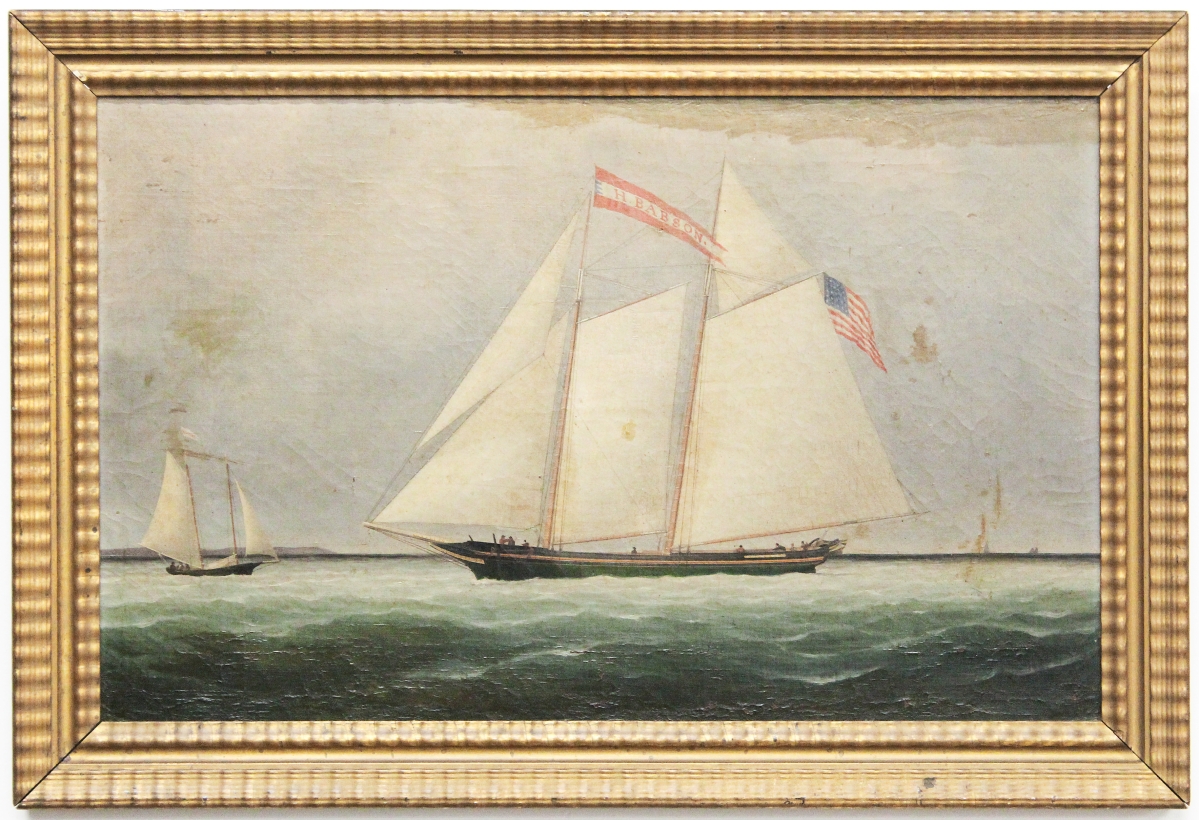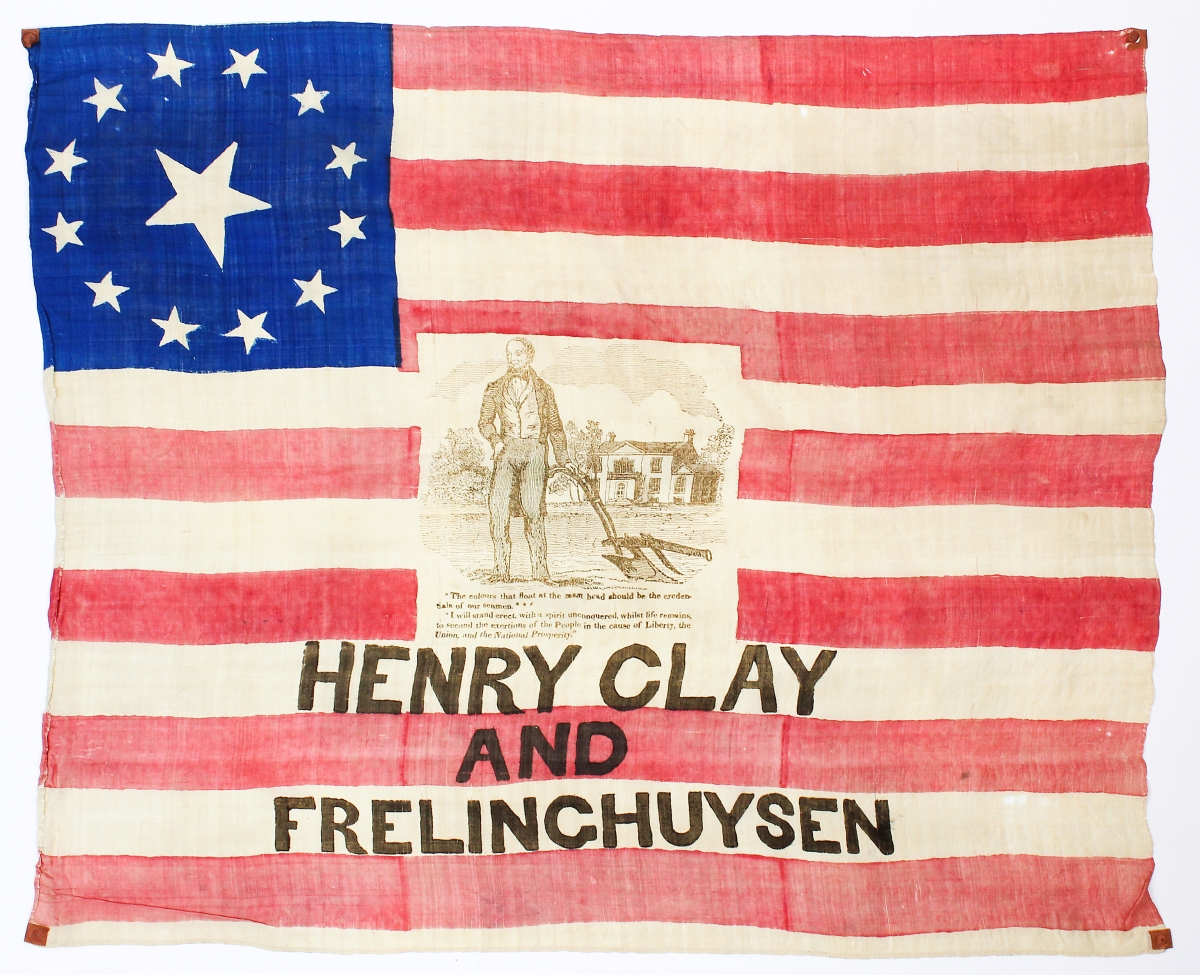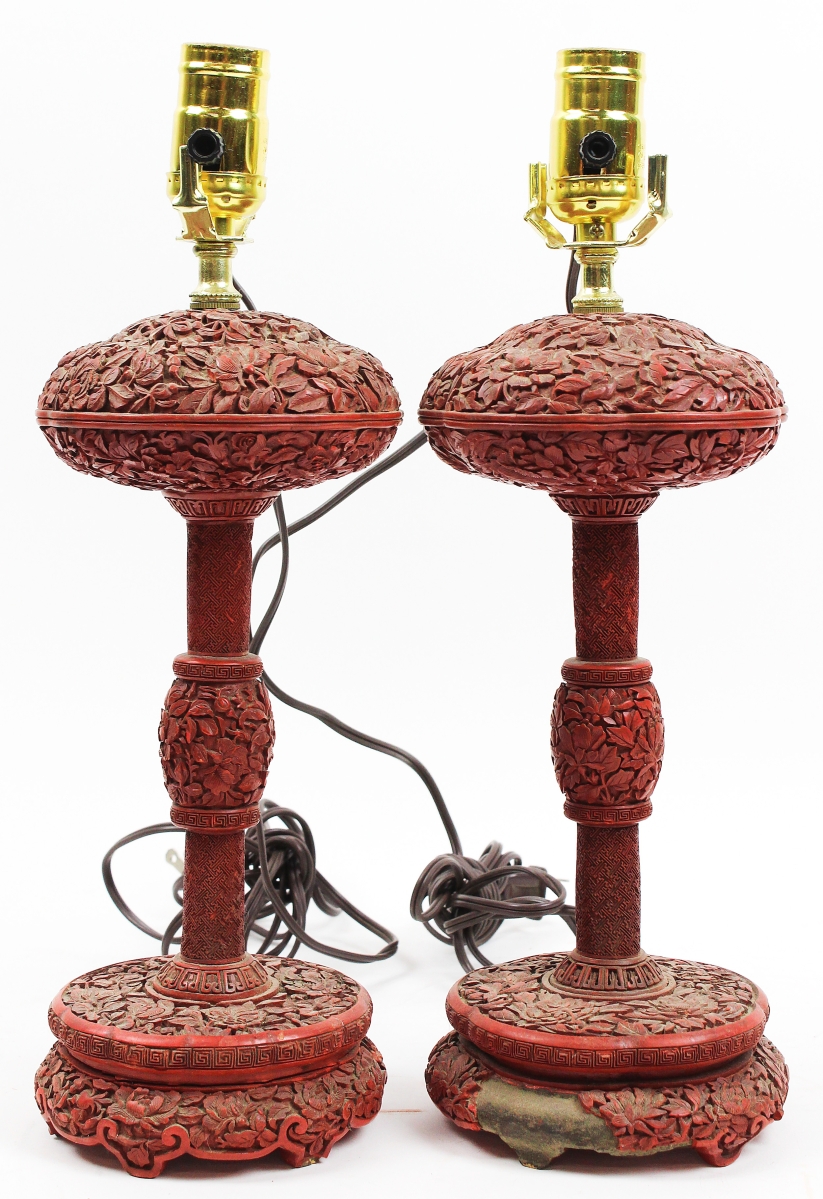
An unsigned American school oil on canvas of the schooner ship H. Babson, which had descended in the Babson family, sailed to a strong finish, bringing $51,750 against a $2/4,000 estimate.
Review by W.A. Demers, Photos Courtesy Merrill’s Auctioneers and Appraisers
WILLISTON, VT. – Characterized as the “best collection of Vermontiana to be offered in a decade,” Merrill’s June 18 sale of art and Americana lived up to its billing with a lifetime collection that included excellent paintings by Charles Heyde, paintings and Civil War letters from James Hope, documented Vermont furniture, clocks by Curtis and Dunning, Vermont tall case clocks, silver, jewelry and more. About 2,000 registered bidders were lined up for the material, including online participants, although Ethan Merrill said the house welcomed about 75 bidders in the gallery, the largest in-person gathering since Covid restrictions were lifted.
The reason might have been the local nature of the collection, amassed since the 1970s by a gentleman who worked as a real estate professional and acquired all things Vermont – from Eighteenth and early Nineteenth Century paintings to furniture and decorative arts. Merrill estimated that about half of the sale’s top 20 lots came from this collection.
An unsigned American school oil on canvas of the schooner ship H. Babson, which had descended in the Babson family, sailed to a strong finish. Despite a repaired tear and the noted need for a cleaning, the Nineteenth Century 18-by-30-inch painting charmed bidders, who took the work to $51,750 from its $2/4,000 estimate. Two phone bidders vied enthusiastically for the painting, and one prevailed.

One of two extremely scarce 1844 US presidential campaign flags for Whig Party candidates Henry Clay and Frelighuysen that captured a combined $44,280, this example printed on silk centered an image of a farmer in the field with his plow and the motto “The colors that float at the mast head should be the credentials of our seamen…”
Extremely scarce, two 1844 US presidential campaign flags for Whig Party candidates Henry Clay and Frelighuysen captured a combined $44,280, both going to a private collector. Printed on silk, one centered an image of a farmer in the field with his plow, the flag carried the motto “The colors that float at the mast head should be the credentials of our seamen” and “I will stand erect, with a spirit uncinquered, whilst life remains, to second the exertions of the People in the cause of Liberty, the Union, and the National Prosperity.” In overall good condition, bright colors and small bits of glued ribbon with tack holes at all four corners, the flag measured 25 by 27 inches.
At the 1844 Whig National Convention conducted on May 1 in Baltimore, Md., the Whig Party’s candidates were former Senator Henry Clay of Kentucky for president and former Senator Theodore Frelinghuysen of New Jersey for vice president. The Whigs had been successful in winning the 1840 presidential election, but need a new ticket as President William Henry Harrison had died in April 1841, while his successor, John Tyler, had been expelled from the party in September 1841 for vetoing bills passed by the Whig-controlled Congress. The Whig ticket went on to lose the 1844 general election to the Democratic ticket of James K. Polk and George M. Dallas.
Charles Louis Heyde (1822-1892) was a prominent New England landscape painter who lived in Vermont from the early 1850s until 1892, becoming one of that state’s most prominent late Nineteenth Century landscape painters. In 1863, he was commissioned by the state of Vermont to paint the Vermont coat of arms. He first visited the Green Mountain state in 1852 searching for inspiration for his landscapes and found what he was looking for in the state’s spectacular scenery. Four years later he moved permanently to Burlington, and for nearly 35 years painted the scenic views popular with visitors and residents of the region. Mount Mansfield, Lake Champlain, the Winooski River and Otter Creek were his signature subjects. In this sale, a local bidder won “Mount Mansfield in Autumn,” oil on canvas landscape signed on the bridge, for $23,370. It had been included as #10 in the Fleming Museum exhibition catalogue raisonné and measured 17 by 34 inches. One gentleman, an underbidder, had driven all the way from Massachusetts to bid on it, expressing dismay afterwards that he had not bid more.
_mt_mansfield_in_autumn_23370.jpg)
Charles Louis Heyde (1822-1892), a prominent New England landscape painter who lived in Vermont from the early 1850s until 1892, painted “Mount Mansfield in Autumn,” an oil on canvas landscape signed on the bridge, which realized $23,370. It had been included as #10 in the Fleming Museum exhibition catalogue raisonné and measured 17 by 34 inches.
Vermont furniture also came to the fore in this sale. Fetching $10,455, a circa 1820 Jericho, Vt., 6-foot harvest table in original red surface featured a single pine board top and drop leaves, maple turned legs and sides and double swing supports. All in original dry red surface, the 21-by-72-by-30-inch table with 11-inch-wide leaves, had originally been purchased from longtime Vermont collector Percie Brigham.
A Jordan Post, Vergennes, Vt., tall case clock took $9,225. It had an engraved brass face with a scene most likely of the British 82-foot, 16-gun brig Linnet about to engage the American-held Fort Cassin, which was protecting the American fleet being constructed by Commodore McDonough at the foot of the falls on Otter Creek in Vergennes. Aside from its historical content, the 90-inch-high clock featured brass works, pine case, tombstone arch top belly door and some old repairs to the hood and door of the hood. It had previously been sold by Duane Merrill and had formerly resided in the Vergennes Inn, as attested by some guest signatures inside its door.
Also going out at $9,225 was a pair of Oriental cinnabar lacquered table lamps, one with losses at base, overall heights of 15 inches.
Worthy of a Ken Burns treatment were four Civil War letters from James Hope (1818-1892), who served as a captain with the 2nd Vermont Volunteer infantry. Finishing at $7,380, the lot’s letters were mostly dated 1861, and there were six sketches of camp life, including drawings of batteries, the inside of a tent and a depiction of the camp during the Peninsula Campaign with Thaddeus Lowe’s balloon “reconnoitering” in background. Along with images of Camp Marey and Camp Griffin, the letters are mostly addressed to Hope’s daughter Jessie (1850-1894) with one to Jessie and Addie (1848-1871). Writing in a fatherly style, Hope encourages the girls to help their mother while he is away at war and fields requests for toys.

Among notable Vermont furniture, this circa 1820 Jericho, Vt., 6-foot harvest table in original red surface fetched $10,455.
An Ernest Parton (American, 1845-1933) oil on canvas landscape painted on the Saco River, Maine, 30 by 50 inches, housed in a resplendent gilt gesso frame and signed lower right dated 1871, was bid to $7,380. Parton was born in Hudson, N.Y., at the region’s heyday of artistic activity by Thomas Cole and his Hudson River School. The self-taught landscape artist was largely inspired by his older brother, Arthur, who inspired him to paint from nature rather than to learn by formal training. Parton traveled to Europe in 1873, intending to visit for a few months, but ended up staying after finding success in London; he split the rest of his life between England and France.
Chairs of note included a set of six Shaker chairs in walnut with rush seats that left the gallery at $3,997 and an Eighteenth Century continuous arm Windsor, possibly Boston, in original black paint with nine-spindle back, turned arm supports, saddle seat and strong turned legs with H-stretcher that made $3,075.
Decorative arts highlights included a Nineteenth Century Thomas Barker Enterprise Fire Club fire bucket, Salem, Mass., founded 1810, at $2,091 and a collection of five Nineteenth Century deep blue Historical Staffordshire transferware soft paste porcelain dinner plates by Enoch Wood at $4,766. The plates were decorated with scenes depicting “Commodore MacDonnough’s Victory” on Lake Champlain during the War of 1812.

Going out at $9,225 was this pair of Oriental cinnabar lacquered table lamps, one with losses at base, overall heights of 15 inches.
A gilt-bronze Japanese Buddha in gold gilt-lacquered shrine standing 6½ inches high earned $4,612, while a Nineteenth Century heart-shaped cast iron windmill weight, signed “L Houston, Montgomery, Penn., patented June 17 1884 April 14 1885” weighed in at $3,997, and The World in Miniature, circa 1821-23, edited by Frederic Shoberl, R. Ackerman, London, a complete first edition set of 43 volumes garnered $3,382.
And bidders were charmed by an early attributed Steiff mohair teddy bear with shoe button eyes, pointed nose, humped back, long bent arms and took the 13-inch bear to $2,583. He had no ear tag but lots of character, having been well used and loved.
Prices given include the buyer’s premium as stated by the auction house. The firm’s next sale, offering a selection of watches, continental material, decorative arts and furniture, is scheduled for July 16. For information, 802-878-2625 or www.merrillsauction.com.


_saco_river_me_7380.jpg)
_civil_war_letters_home_with_sketches_7380.jpg)











_mt_mansfield_in_autumn_23370.jpg)




